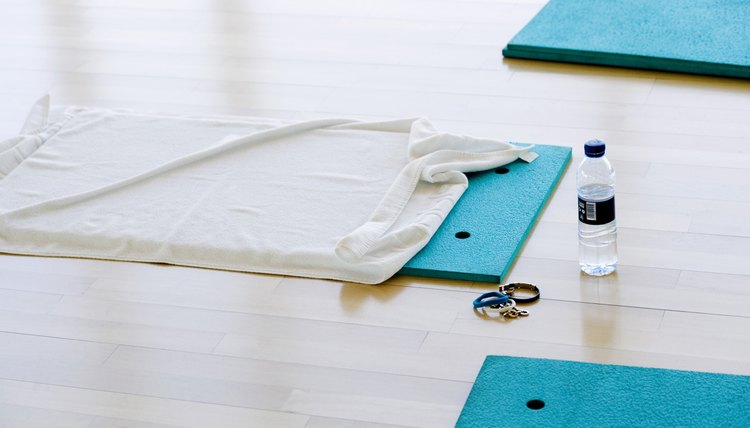What Muscle Groups Do Lying Straight Leg Raises Work?

All you need to perform the lying straight leg raise is an exercise mat. The weight of your own leg provides the resistance that your muscles have to overcome. Lie on your back on the mat with both of your legs extended and your arms down by your sides. Keep your knees straight as you pick your legs up until they’re pointed straight up to the ceiling. You can either lift both legs up simultaneously or lift one leg at a time. It’s the muscles at the front of your hips that lift your legs.
Iliopsoas
The major muscle responsible for lifting up your leg during the lying straight leg raise is the iliopsoas. The iliopsoas is one of the hip flexor muscles located at the front of your pelvic bone. It originates at the ilium and sacrum of your pelvis and then runs over the front of your hips and inserts at the top of your femur bone. When it contracts, it pulls your leg up toward your chest, flexing your hip.
Other Hip Flexors
The other muscles included in the hip flexors also contribute to the lying straight leg raise. The other hip flexor muscles include the sartorius, pectineus, tensor fasciae latae, rectus femoris, adductor longus and adductor brevis. All of these muscles are located around the front of the hips, except for the tensor fasciae latae, which is set to the side of your pelvic bone.
Stabilizing Muscles
A few other muscles are recruited when you perform the lying straight leg raise, but they’re not involved with lifting up your leg. The rectus abdominus, which is the major muscle in your stomach, and your obliques, located on both sides of your torso, isometrically contract to stabilize your pelvis and hips. Your quadriceps muscle group, located at the front of your thighs, also isometrically contracts to prevent your knee from bending as you lift up your leg.
Considerations
To increase the challenge of the lying straight leg raise, increase the amount of resistance your hip flexors have to overcome. One way to do this is to strap ankle weights around your ankles. Another option is to attach a pulley cable or resistance band to your ankles. While the hamstrings at the back of your upper thighs aren’t recruited during the lying straight leg raise, and when you lift your straight legs up toward the ceiling, you’re lengthening the hamstrings and thus performing a dynamic stretch on that muscle group.
References
Writer Bio
Kim Nunley has been screenwriting and working as an online health and fitness writer since 2005. She’s had multiple short screenplays produced and her feature scripts have placed at the Austin Film Festival. Prior to writing full-time, she worked as a strength coach, athletic coach and college instructor. She holds a master's degree in kinesiology from California State University, Fullerton.
